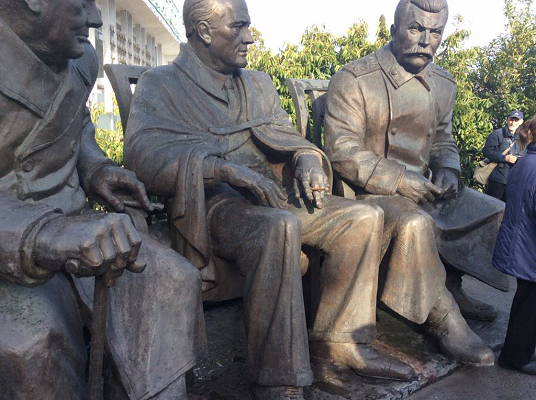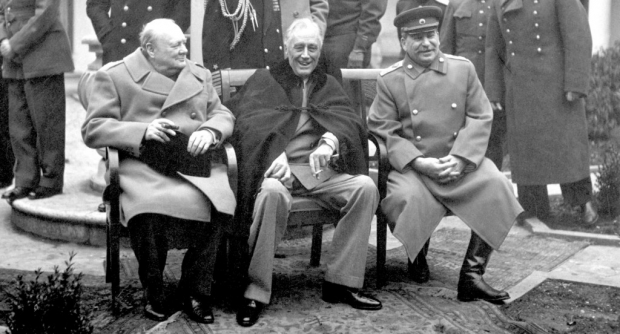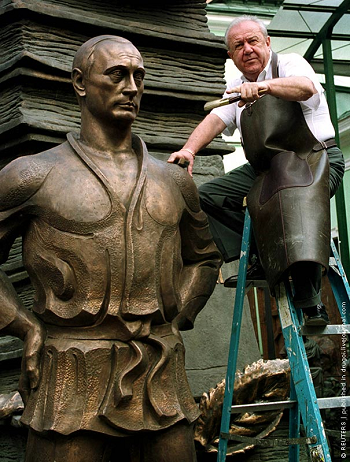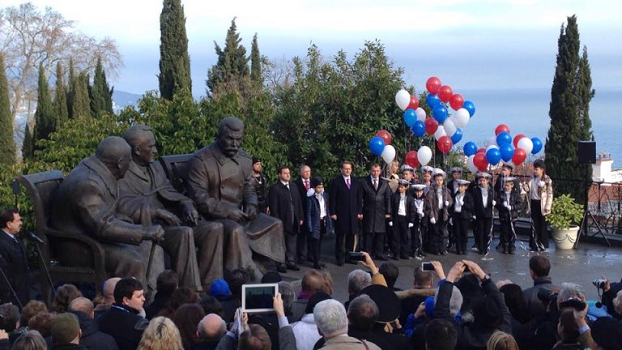
On January 31, 2015 a monument of leaders of the “Big Three” – Churchill, Roosevelt and Stalin was opened in Yalta in honor of the 70th anniversary of the Crimea Conference of the Allies.
The Crimean (Yalta) conference of heads of governments of the three Allied powers of the anti-Hitler coalition – USSR, USA and Great Britain – took place in February 1945. The venue of the formal meetings became Livadia Palace, which at the time of the conference had been also the seat of Roosevelt and other members of the American delegation. The British delegation was placed not far away, in the other Crimean palace, in the Vorontsov Palace in Alupka. The Soviet delegation headed by Stalin lived at the Yusupov Palace.
The Conference of 1945 laid the foundations of the post-war world order. (Editor’s note. Yalta was vitally important but was somewhat an extension of earlier conferences and arrangements discussed and tacitly arrived at.)
The monument was installed in the territory of Livadia Park area near Levadia Palace. The total weight of the three sculptures – Stalin, Churchill and Roosevelt – along with the pedestal is about 10 tons. The width of the composition is a little less than six meters; the height of each sculpture – about 320 centimeters.
The monument follows the famous photograph taken at the end of the Yalta Conference, where the leaders of the Soviet Union, Great Britain and the United States are sitting in the courtyard of the Livadia Palace.

The monument of the “Big Three” was created ten years ago by Zurab Tsereteli, a famous sculptor and the President of Russian Academy of Art. Tsereteli presented the monument as a gift to Crimea (then a province of Ukraine) for the 60th anniversary of the Yalta Conference. He had chosen May 9, 2005 as a possible date of opening.
Tsereteli’s gift had created a great controversy in Crimea and in the entire Ukraine. Since the fall of Communism no new monument of Stalin has been erected in any part of former Soviet Union. Erecting a monument to Stalin was especially protested by Crimean Tatars. By decision of the Stalin’s leadership in 1944 the entire Crimean Tatar People was deported from Crimea on charges of collaboration with the German occupiers. The Ukrainian government took the protests of Crimean Tatars seriously and 10 years ago the monument to “Big Three” was not erected.
Tsereteli has a long record of giving gifts to different countries and cities which have been rejected. The most known is the story of his monument to Christopher Columbus. The 600-ton monument, which stands at 350 ft tall, twice the height of The Statue of Liberty without its base, was given by Tsereteli to the United States as a gift of friendship to commemorate the 500th anniversary of Columbus’s discovery of the New World in 1492. The monument was shunned by cities across America. The colossal statue has finally found a home in Puerto Rico after a two-decade quest.
In 2004 Zurab Tseriteli created a giant monument of Vladimir Putin. The Russian government rejected idea of locating the monument in a public place. The representative of the Kremlin stated: “We did not expect from such a well-known and successful art figure such manifestations. It is widely known that President Putin takes such things negatively”.
Tsereteli answered: “I worked hard for two years trying to show the wisdom of our president. I’ll place the sculpture in a museum for future generations to see his wisdom”.

Tseriteli with his Putin monument.
The sculptor finally got lucky with his monument to the “Big Three”. The opening of the monument was considered a good chance to stress one more time the idea of legitimacy of the Russian presence in Crimea. The monument had been innaugurated by the speech of Sergei Naryshkin, Speaker of the State Duma of Russia and the Chairman of Russian Historical Society.
“The opening of the monument” said Naryshkin, “is another warning to the politicians and the historians–speculators that are trying brazenly and cynically to distort the history of World War II and the postwar world.”

In the Mejlis of the Crimean Tatar People the erection of the monument was called blasphemy.
“The attitude of the Crimean Tatars to Stalin is well known. If the monument will be erected, it will be open demonstration of the attitude to the memory of our people”, – said a member of the Majlis Abdurahman Egiz.
According to him, “the authorities must understand that they are directly responsible for the consequences of the installation of the monument.”

